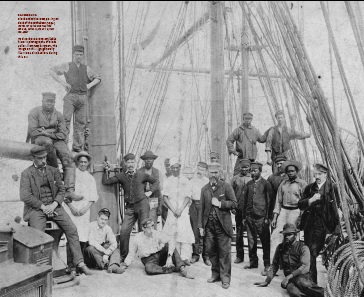NEWBURYPORT – Much has been written about the maritime history of this city, but little attention has been given until recently to the shipbuilders and seamen with black skin.
The Newburyport Black Lives Initiative and the city of Newburyport are changing that.
This week the historic Custom House Maritime Museum has asked one of the leaders of the initiative, senior city planner Geordie Vining, to speak about the role black men played in the city’s maritime industry at its First Friday lecture.
The city is also installing next month an interpretative panel that describes the role black seaman and workers played in the maritime industry that was so crucial to the economic development of this city.
The panel, near the southeast corner of the embayment on the waterfront in the new Market Landing Park on the Merrimack River, will read: “Seafaring was one of the main occupations for Black men in Newburyport and the rest of New England during the 19th century. Sailors on merchant vessels, fishing ships, whalers, and warships faced great hardship and danger, and Black sailors faced significantly more risks than their white crewmates.”
Vining’s lecture, “Expanding the Spotlight: Black Mariners during the Age of Sail,” will be at 6:30 p.m. Friday, June 7. Members may attend for free, guests for $10. It will last about 45 minutes with a 15-minute question and answer session.
According to the interpretative panel, “Estimates are that nearly one in five American sailors was Black in the 18th and 19th centuries. During the American Civil War, one in four U.S. Navy sailors was Black.”
In her brochures describing the Newburyport Black Heritage Trail, local historian Ghlee Woodworth has devoted much of the space to “Soldiers, Sailors, and Guinea Village” residents. Here are a few individual seaman she highlights:
During the Revolutionary War, a black seaman, Commander John Lee, worked for John and Nathaniel Tracy who built ships on the central waterfront. Owners of privateers, warships to capture the enemy, the Tracys chose Lee, a 40-year-old, 5-foot-4 inch man with black skin, to command the Schooner Hawke. A year later, he commanded the Brig Fancy, the Brig Tom in 1779 and the Ship Grand Monarch in 1781.
When the Brig Fancy was captured in August of 1777, Lee and his crew were jailed in the Mill Prison in England where Newburyport resident Charles Herbert, who was also an inmate, wrote in his diary of their imprisonment and eventual escape to Spain.
John and William Osborne, who lived at 34 Ocean St., were seamen during the Civil War. William served on the steam engine gunboat, USS South Carolina, that as part of the Gulf Blockading Squadron, captured 16 Confederate schooners.
His brother, John Osborne served on the USS sloop-of-war Brooklyn, which participated in the Union Blockade of the Confederate States and attacked Confederate forts and other installations on the Mississippi River. He joined the USS Richmond and was part of the squadron in the Battle of Mobile Bay, AL. Military records describe seaman Osborne as a 5-foot, 4-inch mulatto.
In 1865, the ship Montana, built by John Currier, Jr., in Newburyport, set sail with an entirely black crew, recruited from Boston and New Bedford. Only the officers and apprentices were white, according to the Newburyport Herald. The Montana sailed to New Orleans with a stop in Mobile, which showed the captain with the Civil War over did not fear the crew being kidnapped.
The Montana then sailed across the Atlantic Ocean to Liverpool, England, around Africa to Calcutta, India, and back to Boston. The captain sent a telegram noting that he and his crew had accomplished the “shortest passage ever made by a sailing vessel” between Liverpool and Calcutta, a journey of more than 8,600 nautical miles, in 85 days.
Of particular concern for black mariners who traveled to southern ports before emancipation was the possibility they would be captured and jailed under state-enacted Negro Seamen Acts. Vining’s lecture will feature a discussion of the Negro Seaman Acts, which gave white southerners the right to kidnap black seaman.
In what is called the “Reverse Underground Railroad,” thousands of black sailors were imprisoned and sometimes sold into slavery. The Negro Seaman Acts required the captain to pay fees to get his black seaman out of jail. If the ship left without the captain paying, the seaman could be jailed indefinitely or sold.
Despite protests from northern states and foreign countries, the Negro Seaman Acts persisted throughout the Ante Bellum era. An estimated 10,000 black seamen were imprisoned under these laws.
In 1863, the Newburyport-built merchant ship Sonora was sailing with an all-Black crew and white Newburyport officers when a Confederate privateer called the Alabama attacked her off the coast of Malaysia. In reports published in the History of the Marine Society of Newburyport, the captain and first mate described how the privateer not only plundered and burned the ship, but, using racial slurs, cast the officers and Black sailors adrift in small boats rather than landing them safely on shore.
They traveled 80 miles to the port of Malacca as reported by a Black sailor named Charles S.
The city if planning a ribbon cutting for the new waterfront park and the bulkhead repair on June 17. The sign maker will install a temporary digital print panel on stanchions next week.
Honoring Black Mariners of Newburyport
Tuesday June 04, 2024

Photo that will be on the interpretative sign



